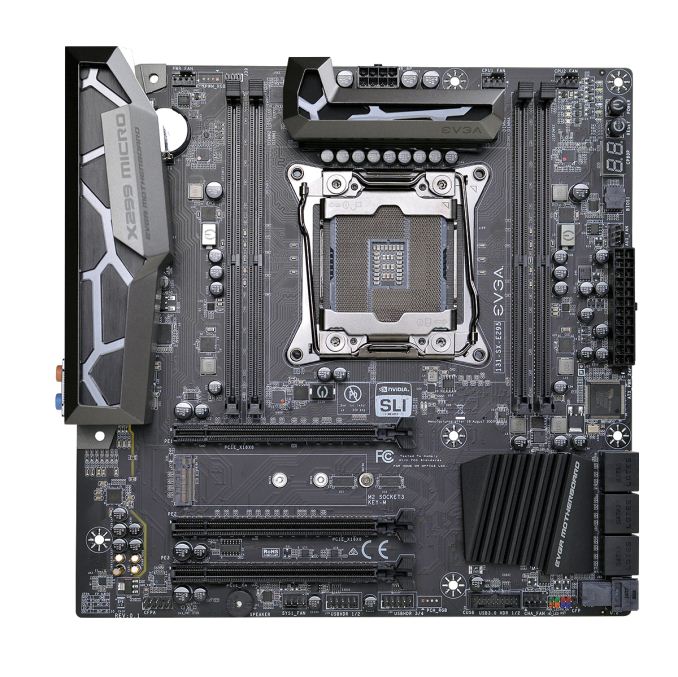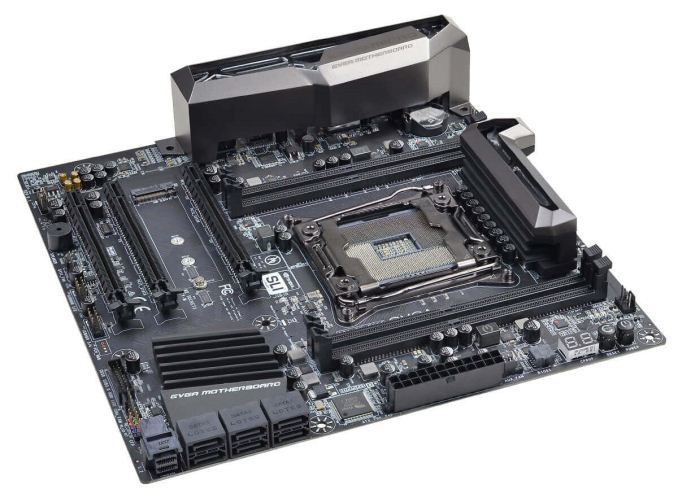The EVGA X299 Micro Motherboard Review: A Smaller Take on X299
by Joe Shields on February 9, 2018 9:00 AM EST- Posted in
- Motherboards
- Intel
- U.2
- X299
- Skylake-X
- Kaby Lake-X
The EVGA X299 Micro is priced at $290 from Amazon US. Being microATX in size, there are only a few competitors in the space, such as the the X299M Gaming Pro Carbon AC and X299M-A Pro from MSI. For users that want to get even smaller, the mini-ITX ASRock X299E-ITX/ac also exists, which we reviewed.
Conclusions
The Micro stands up well compared to the other smaller-than-ATX X299 motherboards, particularly when there is a need for U.2 support as the EVGA X299 Micro is the only one to have a U.2 port. There is a downside to this, as the other boards have dual M.2 slots instead. Those features aside, the difference between the smaller X299 boards comes down to integrated RGB LEDs, which the Gaming Pro Carbon has, or included wireless capabilities which only the X299M-A Pro lacks. It will be a feature trade off depending on user requirements, and we are waiting for the others to come into our hands for testing.
That said, the EVGA X299 Micro has most of what we would need on a PC. Most users will be sufficient with 'only' six SATA ports, or a single M.2 port, or 64 GB of DRAM: it could easily be argued that if a user needs more than this, then other ATX are available. As the EVGA X299 is a smaller board, there are natural tradeoffs
The EVGA X299 uses a reasonably robust 12-phase power delivery, with Infineon power stages, that handled stock settings and our overclocked options without issue. The power delivery heatsink, an important part of that ecosystem, worked well keeping temperatures in check during our overclocking adventures.
Overall, I am pleased with how the Micro turned out, but improvements can be made. The curious issue I had with the beep codes and getting the system to boot was a somewhat frustrating experience. We are not sure what was going on (speculating a memory training issue), but EVGA is aware of the problem we ran into and is looking into it. The stock performance in AVX tests was lower than the other boards which is something users should be aware of, but EVGA relayed to us that this is the Intel specification and other boards technically go outside of Intel spec, and thus are getting better results in those tests. Outside of that, I would have liked to see EVGA put the back panel shroud and Wi-Fi card on the board automatically. Despite a user being in the process of building a full PC, it did feel odd to also have to finish putting together the motherboard, regardless if it only takes a couple of minutes to do it.
In the end, EVGA has given users a solid choice for a small form factor motherboard. While not without its quirks, the Micro has enough features an options to satisfy a large cross section of users from the gamer and enthusiast crowd, and even to the professional users given its high horsepower and fast storage options. Its pricepoint places it in position between the other MicroATX (and ITX) offerings, so it really will come down to each user and what they need, want, and can do without. The other side of it is EVGA's warranty strategy, which bypasses retailers and goes straight to them directly.
- The Intel Skylake-X Review: Core i9-7980XE and Core i9-7960X Tested
- The Intel Skylake-X Review: Core i9-7900X, i7-7820X and i7-7800X Tested
- The Intel Kaby Lake-X Review: Core i7-7740X and i5-7640X Tested
- Intel Announces Basin Falls: The New High-End Desktop Platform and X299 Chipset
- ($400) The ASRock X299E-ITX/ac Review [link]
- ($400) The GIGABYTE X299 Gaming 7 Pro Review [link]
- ($390) The ASRock X299 Professional Gaming i9 Review [link]
- ($370) The ASUS Strix X299-XE Gaming Review [link]
- ($350) The MSI X299 Gaming Pro Carbon Review [link]
- ($340) The ASUS X299 TUF Mark 1 Review [link]
- ($330) The EVGA X299 FTW-K Review [link]
- ($290) The EVGA X299 Micro Review (this review)
- ($290) The ASRock X299 Taichi Review [link]
- ($280) The MSI X299 Tomahawk Arctic Review [link]
- ($260) The MSI X299 SLI Plus Review [link]












23 Comments
View All Comments
casteve - Friday, February 9, 2018 - link
"This showcases one of the downsides of a HEDT system: while other platforms (like Z170) were getting under 100 regularly, the additional featureset of these large platforms results in a higher DPC Latency."I don't think it's the feature set. It just showcases that Intel failed to optimize for DPC latency with this chipset. eg: z77 good dpc latency, z87 bad, z97 and 170 good... sometimes Intel is on the ball, sometimes it isn't.
jabber - Friday, February 9, 2018 - link
Excellent, a X299 board for the over 25's!wolfemane - Friday, February 9, 2018 - link
Hey some of us over 25's are kids at heart... and have kids. I love RGB. I'd happily add RGB to a system with this board.DanNeely - Friday, February 9, 2018 - link
OTOH even at 18 I'd've probably been like "Really?!?!?" Other than being brushed aluminum when that was still far from common the case I used for the system built right after my 20th was mundane as they come.Samus - Saturday, February 10, 2018 - link
Ditto. Even when I was a teenager I preferred the look of my corporate-class Prolinea or industrial design of a boxy Lian-Li to something with a window and lights. The most adventurous thing I've done is put a LED in my water pump so I can tell when the coolant is flowing.peevee - Friday, February 9, 2018 - link
Isn't having only 2 memory slots defeats the purpose of X299-compatible CPUs?DanNeely - Friday, February 9, 2018 - link
It has 4, 2 on each side. It's still quad channel so you get the double bandwidth vs the mainstream dual channel CPUs. You're still down 50% on capacity; but between the larger socket size of LGA20xx (AMD Epyc with a ~3500 pin socket is even worse, to the extent that something like half the board for it are the even larger E-ATX form factor that's rarely been used outside of 2 socket boards in the past) and all the extra stuff the bigger CPUs can support there's not enough space on the PCB to do everything that the CPU itself could do on anything smaller than a full ATX. Micro ATX with these CPUs requires picking and choosing what features you need instead of just taking everything.Samus - Saturday, February 10, 2018 - link
Basically, if you need more than 32GB of memory, you are better off spending more on a bigger board because the cost of high-density DDR4 will effectively kill any cost savings. ie, 4x8GB DIMMs are substantially cheaper than 2x16GB DIMMs.cosmotic - Friday, February 9, 2018 - link
On the first page: "This specific review will cover the ASRock X299E-ITX/ac." (probably pasted from said review to this one, which is for an EVGA board)Joe Shields - Monday, February 12, 2018 - link
Updated.